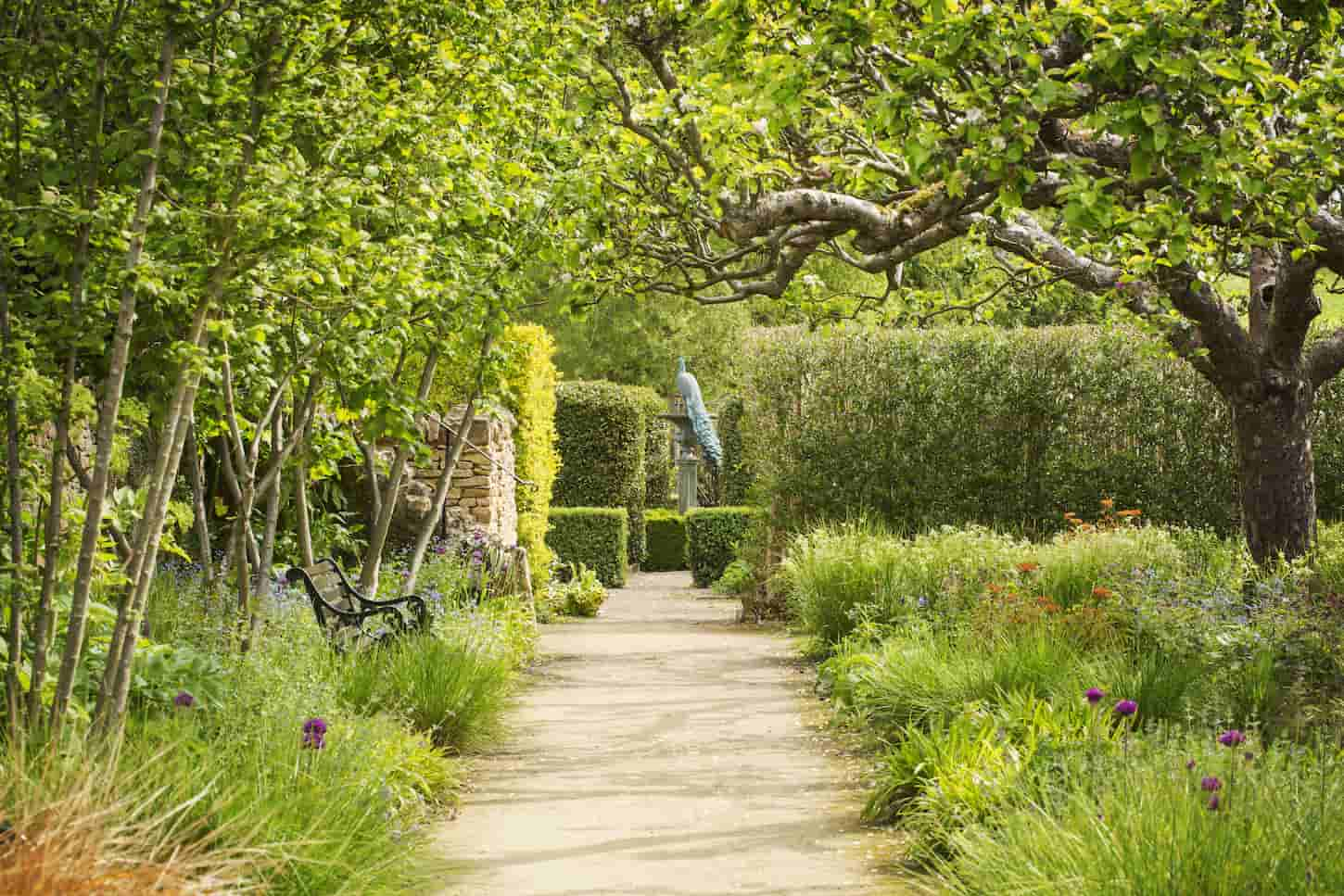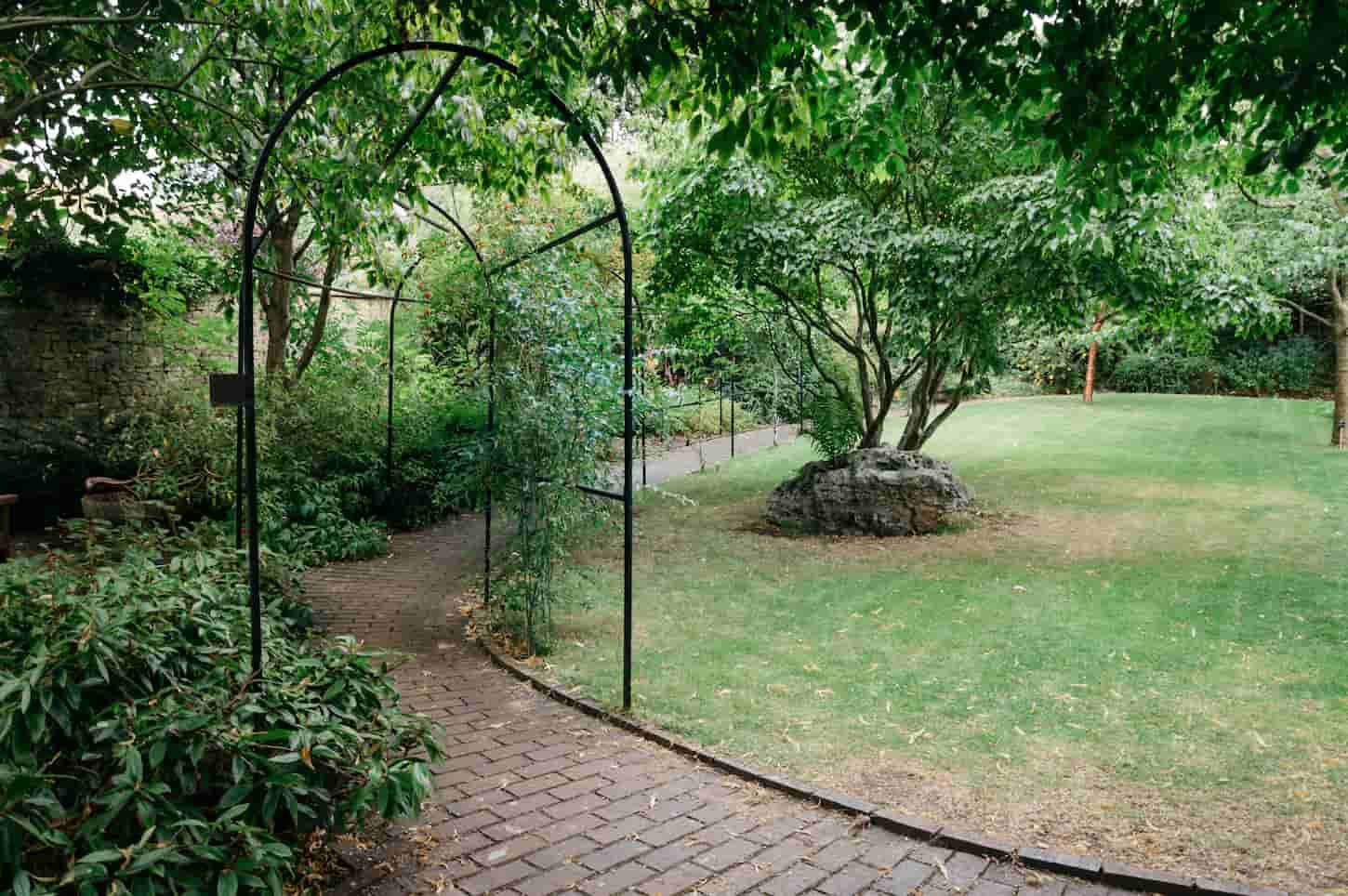Nowadays, garden design is a successful field, and it’s not as easy as it looks. One of the more common requests is making a big garden low maintenance, which is more complicated than it sounds.
Design and build your garden using fewer high-maintenance plants and native species to make a big garden low-maintenance. Opt for plants with similar care requirements to cut down on time. Include paths, grass areas, areas for activities, and seating pieces to minimize empty space.
There’s more to this than meets the eye, such as controlling weed growth, choosing the path to install, and making your garden accessible to all ages and abilities. Read on to learn all about low-maintenance gardening.

What Is the Lowest Maintenance Garden?
The lowest-maintenance garden should have no more than eight plant species with similar sunlight, watering, and fertilizer needs. Spread these plants two feet apart and cover the garden with wood chips or pebbles.
Lawns are also an effective (and attractive) way to lower the maintenance needs of a garden in some areas, water permitting. Installing seating areas, activity areas, fire pits, and playgrounds will also lower maintenance needs.
How Do I Make My Large Garden Low Maintenance?
We can do a few things to make the garden low maintenance. Keep a small number of plants in the garden. People often think greener automatically means better, but a garden is more than green plants.
Instead of overpopulating the garden with plants, make a pebble trail through the garden and invest in non-plant decorations. Pebbles don’t need much maintenance, and we can also include a fire pit and a sitting area in the middle of the garden.
Unlike plants, which need weekly maintenance, fire pits and seats usually only need maintenance once or twice a year. We can also add a large bird bath – they take up space, so it won’t seem empty, and they naturally fit into gardens. Aside from cleaning twice a year, bird baths don’t require much work. And you’ll attract birds.
On top of planting fewer plants, ensure at least two feet of space between the plants. If we grow them too closely together, maintenance will be more difficult as the plants grow larger.
Garden borders look nice, and they can be low-maintenance, too! Click here to find out how.
How Do I Make My Large Yard Low Maintenance?
A yard should combine plants, activity areas, and grassy lawn sections. Having a yard be all of one thing usually requires more maintenance than using sections, especially in a large yard. Instead, design the yard to incorporate all aspects to maximize the space for your family’s enjoyment.
Design activity areas
If you’ve got a large yard, having it all out and open is only a good idea initially. Pretty soon, you realize there’s a lot of wasted space – and a lot of extra mowing and weeding.
Instead, design activity areas within the yard. Design one area for your vegetable garden while another for a flower garden or a gazebo for reading. Take your family’s interests into account when you do this design. There’s no limit on what you can build, provided you can first dream and design it (and then it fits within the budget, too!).
Or if you’ve got backyard animals, make sure you design an area for each of them (or each group housed together).
For example, we’ve got a trampoline and a playset. So we’ve got a play area within our yard. We’ve also got a raspberry patch, our old garden (that we’re moving), a small orchard area, a grassy play area (more on green spaces next), a chicken area, and we’re planning a raised grow bed area next to the house (to be our new garden).
As our kids grow, they want to change some activity zones – and that’s just fine. We can do that (within reason!).
Create green space
In this case, the lawn is our friend, as it is very easy to take care of. We may have to mow once a week or every other week, but it is mostly self-sustainable.
A large patch of grass in the center of a yard can be a great focal point. We can install a seating area or use it as a playground for children.
We’re at a significant advantage with our yards regarding maintenance because we have an excuse to leave many open space in the form of grass. Our kids love running in it, so the lawn is a grass and activity space for us.
However, our area has a drought, so watering the lawn is an issue. We’re looking into replacing what’s left of our lawn (the last summer was particularly bad for water here) with native grasses and flowers. We’re looking at a mix of grasses so that it’ll look relatively good even if we let it grow longer than a traditional suburb lawn gets.
The type we’re looking at will grow 3 to 4 inches tall – and then stop. So it’ll be on the long side, but it should mean much less mowing. Our kids are excited about that! Thankfully, we don’t have an HOA to worry about. If we did, we’d have to ensure that our lawn-replacement plans complied with those covenants – or get a variance.
Pro tip: grow a lawn of native grasses and flowers if possible. Then, let it grow. You’ll have far less mowing to do – and you’ll be helping the butterflies and local bird populations.
Be smart with plant choices
As you build your backyard garden or backyard, make sure you’re smart with plant choices.
- Don’t plant things that won’t grow easily within your zone.
- Consider using native or drought-tolerant plants if water is a concern in your area.
- Use trees for shade.
- Plant shade-tolerant plants under the trees.
If your city or area has a water conservation district, check with them. Many offer free landscape design classes to help you focus on water-smart plant choices. But hey – it’ll also help you design the yard!
Connect areas with paths
We can also install a path around the yard or connect the various areas.
Before you build the path, think about what you’ll be doing around the path.
For example, I suggest using wood chips instead of rocks if you build a path through the grass. This has nothing to do with aesthetics – it’s easier to mow the lawn when we don’t have to be careful about accidentally flinging a pebble at someone with the lawn mower blade. Plus, the lawn mower won’t break if it eats wood chips. Rocks can break it, though!
Use mulch to help control weeds
Something significant to keep in mind is discouraging weeds. When weeds establish, they become one the lengthiest jobs in the garden because we have to rip them out physically.
Mulch can help control the weeds if it is sufficiently thick. You’ll likely need at least 3 inches of mulch for it to be effective, though.
If the mulch alone isn’t enough, and you’re okay with using a preemergent herbicide (it’s far better than other options in my opinion!), then use preemergent herbicides before the weeds germinate (usually in March and April) to ensure you don’t have to rip them out of the ground by hand.
If you want more reading, this NC State source has great info on preemergent herbicides.
How Do You Take Care of a Large Garden?
To make the care of a large garden easier:
- Don’t plant too many plants
- Choose several species, but stick to a roster of no more than 7 or 8 total.
- Water, fertilize, mulch, and prune every one of them regularly.
The most difficult thing about caring for a large garden is the number of plants. Even if they’re all the same species (which is odd since there’s no creativity if you plant 40 identical plants).
When choosing the plant species, choose plants that coexist and have similar living requirements.
This includes fertilizer, sunlight, and water requirements. If possible (although understandable if it isn’t), choose plants that need the same amount of fertilizer in a year and plants that prefer the same (or at least a similar) NPK ratio.
This will make fertilizing easy, as we can do it all on one sunny Saturday and be done with it in a while. Suppose we have plants that require different fertilization timing and different fertilizers.
In that case, we’ll be fertilizing every other week and have to spend more on fertilizers because we’ll have to buy different varieties.
If a garden gets plenty of light, choose plants that need light – not plants that can get burned. If the garden is shady, choose plants that live in the shade and only get partial sun (such as calatheas).
Lastly, another way to make maintenance easy in large gardens is by choosing plants that can survive the winter.
Of course, we’ll have to provide some protection, but it’d be great if we didn’t have to take every one of our plants indoors during the winter.

How Do I Make a Big Garden Low-Maintenance and Water-Smart?
Mulch is one of the most useful additions to the garden. Not only does it discourage weed growth, but it also helps the soil retain water. We can water the plants deeply and rarely instead of frequent surface watering.
If we choose plants with similar water requirements, we can easily water them with a sprinkler.
If the plants have different watering requirements, we must water them at different times in different amounts.
Make sure that none of the plants are covered in any way – that’s how they will make the most out of every rainstorm.
How Do I Make a Low-Maintenance Garden for Older Adults?
First, install garden beds. Crouching and kneeling all day is difficult for younger people and even more difficult for older people. Garden beds require less bending but also help with weed control, as weed seeds cannot invade them easily.
The methods mentioned in previous sections apply to the above question, but there are a few things to add.
Choose plants that require little or no pruning. Some plants – and this does mean some plants – aren’t that susceptible to rotting or dying leaves harming the plant. Their leaves fall off without pruning.
Calatheas, which I’m now mentioning for the second time in this article, is like this. They’re susceptible to sunburns, and if a leaf burns to the point of dying – we don’t need to prune it – it will simply fall off.
Lastly, we can install rubber water hoses around the plants. This can take some initial work, but once we’re done, there is no need to worry about watering.
These hoses, found at most gardening stores, are easy to bend and manipulate to our needs. We can hook them up to a water pipe and spread a single hose around the entire garden, ensuring it passes close to each plant.
Then, we need to pierce a small hole (don’t worry, these hoses are designed to have small holes in them) next to each plant and turn the water on. We can water all the plants in the garden with this method while sitting on our couch. Just make sure to remember to turn the water off!

What Are The Best Low-Maintenance Garden Plants?
The best low-maintenance garden plants are perennials, which return yearly, or shorter-lived plants that put down enough seeds to propagate yearly to make the garden beautifully easy. Using a water delivery system (drip irrigation) with mulch also makes a garden lower maintenance by preventing weeds.
We could name hundreds of species here, but our favorite choices are below. Remember that these plants do not have the same requirements, so they are not a perfect fit for a low-maintenance garden.
They are all just low maintenance on an individual level.
- Hibiscus plants are very hardy and can survive the winter, provided they grow in your zone. They will become dormant when the temperatures drop but return next year.
- Hostas are another great choice, particularly if we have a shady area in the garden. They need virtually no care aside from watering and fertilization.
- Yucca shrubs are another smart choice – hardy, need little water and fertilizer, and no pruning. Aside from picking up the dead leaves off the ground every now and then, there’s next to nothing to care for.
- Winter daphne is a great winter plant that needs very little maintenance but requires a lot of space. It can be a great addition if you have space to fill and don’t know what to do with it.
These are some of our favorites – your favorites will likely vary depending on your preferences and zone (as that impacts what will and won’t grow!).
Key Takeaways and Next Steps
The most important steps to take are lowering the number of plants in the garden and, if possible – planting species with similar requirements. These plants will drastically reduce the time spent on watering, fertilizing, and pruning.
Additionally, ensure to include paths, grass patches, borders, seating areas, or playgrounds in the garden. These take up space but require much less maintenance than plants.
Ready to uplevel your garden more? Here are more articles to keep you going.
Enjoy!
Resources
Learning from your own experience is essential, but learning from others is also intelligent. These are the sources used in this article and our research to be more informed as homesteaders.
- How to Calculate a Fertilizer Ratio. extension.psu.edu/how-to-calculate-a-fertilizer-ratio.
- “Lectures 5 and 6: Preemergence Herbicides.” NC State Extension, weeds.ces.ncsu.edu/weeds-teaching/landscape-weed-management/preemergence-herbicides.
